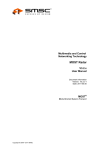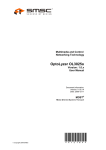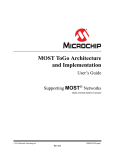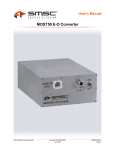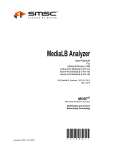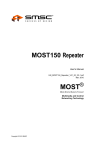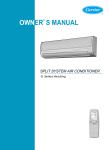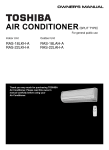Download Technical/Application Note - OptoLyzer G2
Transcript
How to Use Stress Functions and System Flags OptoLyzer OL3150o V1.0.0 Application Note 1 Introduction This application note describes how the stress functions and the system flags of the OptoLyzer OL3150o can be used or manipulated in a MOST network. The OptoLyzer OL3150o provides lock and light stress features and the receive buffer full simulation that are able to simulate some common network error situations. In addition, the OptoLyzer OL3150o offers the possibility to manipulate the shutdown and the system lock flag and to toggle between bypass and slave mode. Thereby it is important to know e.g., when interpreting an acknowledge code how the chips (INIC, SpyNIC for MOST150, StressNIC for MOST150) are arranged inside the OptoLyzer OL3150o. As a result the chip order inside the OptoLyzer OL3150o influences the structure of the MOST network. There are two different kinds of OptoLyzer OL3150o with respect to the internal chip order and thus the document is split in two parts. • Chapter 2 is describing how to use the stress functions, the system flags and the output signal if the chips inside the OptoLyzer OL3150o are arranged as follows: 1. StressNIC for MOST150 2. INIC 3. SpyNIC for MOST150 Normally this chip order can be found in OptoLyzer OL3150o having a serial number less than “3150o22000” 1 . • Chapter 2.2 is describing how to use the stress functions, the system flags and the output signal if the chips inside the OptoLyzer OL3150o are arranged as follows: 1. SpyNIC for MOST150 2. INIC 3. StressNIC for MOST150 Normally this chip order can be found in OptoLyzer OL3150o having a serial number “3150o22000” and higher1. The serial number can be found on the bottom side of the OptoLyzer OL3150o. To be sure the chip order should be requested by an MBI command 2 . In addition, the chip order can be found on the Info tab of the MOST Interface Control 3 . 1 Exception: The order has been changed as a result of a hardware modification. MBI commands are described in the Socket Protocol User Manual that can be got from the technical support (for contact refer to the last page in this document). 3 Starting with OptoLyzer Suite V1.6.0 (also shown on the Info tab of the MOST Interface Control). 2 Confidential Copyright © 2010 SMSC Document Version: V1.0.0-1 Date: 2010-08-24 Application Note Page 1 How to Use Stress Functions and System Flags OptoLyzer OL3150o 1.1 Validity This application note is valid for OptoLyzer OL3150o V1.4.0 and higher. The product version of an OptoLyzer OL3150o can be inquired e.g., via an MBI command or can be found on the Info tab of the MOST Interface Control. 1.2 Device Modes of the StressNIC for MOST150 The following table shows the device modes as they are displayed in the MOST Interface Control in the OptoLyzer Suite. The names of the device modes in the graphical user interface are different for OptoLyzer OL3150o V1.4.x and OptoLyzer OL3150o V1.6.x. StressNIC for MOST150 4 Device Mode ID used in Socket Protocol MBI FBlockID 0xF1 Modes in OptoLyzer Suite V1.4.x Modes in OptoLyzer Suite V1.6.x 0x00 Slave Slave 0x03 Bypass Active Bypass 0x05 (Retimed Bypass 4 ) Retimed Bypass Description Referring to OptoLyzer Suite V1.6.0 Timing slave, visible in the MOST network. Acts like a standard INIC in slave mode. Not visible in the MOST network, but able to manipulate system bits (e.g., shutdown flag) or to run stress modes. Not visible in the MOST network. Received MOST frames will be directed untouched from Rx to the output Tx. Stressmodes are not accessible in Retimed Bypass mode. Retimed bypass mode is accessible only per MBI command when using OptoLyzer OL3150o V1.4.x. Application Note Page 2 Copyright © 2010 SMSC Document Version: V1.0.0-1 Date: 2010-08-24 Confidential How to Use Stress Functions and System Flags OptoLyzer OL3150o 1.3 Stress Functions The StressNIC for MOST150 of the OptoLyzer OL3150o provides the following stress functions: • Lock Stress The lock stress function is available to generate sequences of lock loss errors. Thus the behavior of the DUT can be tested in case lock loss errors are occurring in the MOST network. The duration of the error, the pause between errors and the number of cycles can be adjusted. For more information refer to the online help in the OptoLyzer Suite or to the Socket Protocol User Manual. • Light Stress The light stress function is available to generate sequences of sudden light off scenarios. Thus the behavior of the DUT can be tested in case sudden light off occurs in the MOST network. The duration of the sequence, the pause between light on and off and the number of cycles can be adjusted. For more information refer to the online help in the OptoLyzer Suite or to the Socket Protocol User Manual. • Receiver Buffer Full Simulation Activating the receive buffer full simulation disables the automatic draining and releasing of the receive buffer. As a result of this, any message sent to the StressNIC for MOST150 will be rejected, its NAK (Not Acknowledge) flag will be set. Thus the behavior of the DUT can be tested in case the target device is not able to receive the messages. To activate the receive buffer full simulation the StressNIC for MOST150 must run in slave mode. • Control of Bypass Toggle Stress This test allows switching between bypass (active bypass mode) and slave mode. This means the MPR changes in the MOST network. Thus the behavior of the DUT can be tested if the number of nodes changes in the MOST network. The duration of the StressNIC staying in bypass mode and the duration staying in slave mode as well as the count can be adjusted. The bypass toggle stress does not dependent on the position of the StressNIC for MOST150 in the MOST network and will not be covered in the following sections. Besides accessing these features by MBI commands they can be easily accessed in the MOST Interface Control of the OptoLyzer Suite after connecting to an OptoLyzer OL3150o. The sections 2.1.1 on page 6 and 2.2.1 on page 11 are describing at which position the OptoLyzer has to be placed in the MOST network to use the features. Confidential Copyright © 2010 SMSC Document Version: V1.0.0-1 Date: 2010-08-24 Application Note Page 3 How to Use Stress Functions and System Flags OptoLyzer OL3150o 1.4 System Flags The StressNIC for MOST150 of the OptoLyzer OL3150o also provides the possibility to manipulate system flags. • Control of Shutdown Flag On normal shutdown the MOST device initiating the shutdown will set this flag before switching off the Tx output. The StressNIC for MOST150 is able to remove this shutdown flag. Thus the behavior of the DUT can be monitored while shutting down if this flag is not set (i.e., an irregular shutdown simulation). This property is only available if the StressNIC for MOST150 is in bypass mode (active bypass mode) or in slave mode. • Control of System Lock Flag On normal startup the timing master of the MOST network will set this flag whenever the network is stable. The StressNIC for MOST150 is able to clear the system lock flag. Thus the startup procedure of the DUT can be monitored when this flag is not set. This property is only available if the StressNIC for MOST150 is in bypass mode (active bypass mode) or in slave mode. The system flags can be accessed by MBI commands and can be realized e.g., with an MOST Rapid Control file. The sections 2.1.2 on page 9 and 2.2.2 on page 14 are describing at which position the OptoLyzer has to be placed in the MOST network to manipulate the system flags. 1.5 Output Signal Off and On Simulation The StressNIC for MOST150 of the OptoLyzer OL3150o is able to switch on and off the Tx output. Signal changes at Rx do not impact the signal at Tx if the default behavior is disabled. The signal on and off simulation can be accessed by MBI commands and can be realized e.g., with an MOST Rapid Control file. This function is not available for the Retimed Bypass mode. • • Signal is switched on The MOST network is running in normal operation and the DUT will shut down the MOST network. The StressNIC for MOST150 is able to simulate a false device that keeps the signal on. This allows to test the behavior of the DUT in a situation where the signal stays on continuously. Signal is switched off Two use cases can be differentiated. 1. The MOST network is in NetInterface Off state i.e., the MOST network has not yet been started but shall be started. The StressNIC for MOST is able to set and keep the signal off. The behavior of the DUT can be monitored in case a ring break is simulated by the StressNIC for MOST150. 2. The MOST network is in normal operation i.e., is started and locked. The StressNIC for MOST is able to set the signal off without setting a shutdown flag. Thus it is possible to test whether the DUT detects a Sudden Signal Off and behaves correctly. Application Note Page 4 Copyright © 2010 SMSC Document Version: V1.0.0-1 Date: 2010-08-24 Confidential How to Use Stress Functions and System Flags OptoLyzer OL3150o 2 How to Position the OptoLyzer OL3150o When using the stress functions or the features to control the system flags the position where the OptoLyzer OL3150o has to be arranged in the MOST network depends on the serial number and the hardware of the OptoLyzer OL3150o. If the serial number of an OptoLyzer OL3150o is less than “3150o22000” the chips are arranged as follows 5 : OptoLyzer OL3150o 1. StressNIC for MOST150 2. INIC 3. SpyNIC for MOST150 StressNIC for MOST150 INIC SpyNIC for MOST150 Refer to section 2.1 on page 6 if the serial number of your device is less than “3150o22000”. If the serial number of an OptoLyzer OL3150o is “3150o22000” or higher the chips are arranged as follows 6 : OptoLyzer OL3150o 1. SpyNIC for MOST150 2. INIC 3. StressNIC for MOST150 SpyNIC for MOST150 INIC StressNIC for MOST150 Refer to section 2.2 on page 11 if the serial number of your device is “3150o22000” or higher. 5 6 Exception: The order has been changed as a result of a reparation. Exception: The order has been changed as a result of a reparation. Confidential Copyright © 2010 SMSC Document Version: V1.0.0-1 Date: 2010-08-24 Application Note Page 5 How to Use Stress Functions and System Flags OptoLyzer OL3150o 2.1 Serial Number Less than “3150o22000” 2.1.1 Manipulating the MOST Network via Stress Functions The following test scenarios show how the DUT will function in case of light stress, lock stress or receive buffer full simulation. 2.1.1.1 Light & Lock Stress – DUT Is Timing Slave In this scenario the MOST network must consist of at least two OptoLyzer OL3150o and the device under test (DUT). The order of the devices in the MOST network is the same independent of the kind of stress (i.e., light or lock stress) that should be created. One OptoLyzer OL3150o operates as timing master in the MOST network i.e., its INIC is set as timing master. The StressNIC for MOST150 of this OptoLyzer OL3150o, the first chip inside the OptoLyzer OL3150o, is not used whereas its SpyNIC for MOST150 is spying all data. A second OptoLyzer OL3150o is placed in front of the DUT. Its StressNIC for MOST150 is used to generate stress. This can be done either as slave or in bypass (active bypass mode). The INIC of this second OptoLyzer OL3150o is set in retimed bypass mode. The second SpyNIC for MOST150 can also be used as spy. This setup allows data to be left unchanged behind the second StressNIC for MOST150. The DUT is running in slave mode and so it has to handle the stress scenarios correctly. OptoLyzer OL3150o OptoLyzer OL3150o Rx DUT Tx Rx Not Used Acting as Timing Master Acting as Spy Tx Rx Generating Stress Set in Retimed Bypass Acting as Spy Tx Slave Figure 2-1: OptoLyzer OL3150o Creates Lock and Light Stress while DUT Is Timing Slave Application Note Page 6 Copyright © 2010 SMSC Document Version: V1.0.0-1 Date: 2010-08-24 Confidential How to Use Stress Functions and System Flags OptoLyzer OL3150o 2.1.1.2 Light & Lock Stress – DUT Is Timing Master In this scenario the MOST network must consist of at least one OptoLyzer OL3150o and the DUT. The order of the devices in the MOST network is the same independent of the kind of stress (i.e., light or lock stress) that should be created. The DUT is operating as timing master in the MOST network. The OptoLyzer OL3150o has to be located in front of the DUT. The StressNIC for MOST150 of the OptoLyzer OL3150o generates stress. This can be done either as slave or in bypass (active bypass mode). The INIC must be set in retimed bypass or slave mode. The SpyNIC for MOST150 can spy the data in the MOST network. This setup allows data to be left unchanged behind the StressNIC for MOST150 and so the DUT has to handle the stress scenarios correctly. OptoLyzer OL3150o DUT Rx Tx Rx Generating Stress Set in Retimed Bypass/Slave Acting as Spy Tx Timing Master Figure 2-2: OptoLyzer OL3150o Creates Lock and Light Stress while DUT Is Timing Master 2.1.1.3 Receive Buffer Full Simulation – DUT Is Timing Slave In this scenario the MOST network must consist of at least one OptoLyzer OL3150o and the DUT. The DUT is running in slave mode and is sending messages to a target, in this scenario to the StressNIC for MOST150. The StressNIC for MOST150 is running in slave mode and the receive buffer full simulation is activated. The INIC of the OptoLyzer OL3150o is set as timing master. The SpyNIC for MOST150 is spying all data. This setup (SpyNIC for MOST150 is arranged behind the StressNIC for MOST150) allows checking whether the StressNIC for MOST150 sends a NAK message and whether the DUT is sending e.g., low level retries. Figure 2-3: OptoLyzer OL3150o Activates Receive Buffer Full Simulation while DUT Is Timing Slave Confidential Copyright © 2010 SMSC Document Version: V1.0.0-1 Date: 2010-08-24 Application Note Page 7 How to Use Stress Functions and System Flags OptoLyzer OL3150o 2.1.1.4 Receive Buffer Full Simulation – DUT Is Timing Master In this scenario the MOST network must consist of at least one OptoLyzer OL3150o and the DUT. The DUT is operating as timing master in the MOST network and is sending messages to a target, in this scenario to the StressNIC for MOST150. The StressNIC for MOST150 is running in slave mode and the receive buffer full simulation is activated. The INIC of the OptoLyzer OL3150o is set in retimed bypass or in slave mode. The SpyNIC for MOST150 is spying all data. This setup (SpyNIC for MOST150 is arranged behind the StressNIC for MOST150) allows checking whether the StressNIC for MOST150 sends a NAK message and whether the DUT is sending e.g., low level retries. Figure 2-4: OptoLyzer OL3150o Activates Receive Buffer Full Simulation while DUT Is Timing Master Application Note Page 8 Copyright © 2010 SMSC Document Version: V1.0.0-1 Date: 2010-08-24 Confidential How to Use Stress Functions and System Flags OptoLyzer OL3150o 2.1.2 Manipulating System Flags The following test scenarios show how the DUT will function in case the shutdown flag or the system lock flag is set off (i.e., without correct notification) or the MPR changes. 2.1.2.1 Setting System Flags – DUT is Timing Slave In this scenario the MOST network must consist of at least two OptoLyzer OL3150o and the DUT. The order of the devices in the MOST network is the same for all test functions. One OptoLyzer OL3150o operates as timing master in the MOST network i.e., its INIC is set as timing master. The StressNIC for MOST150 of this OptoLyzer OL3150o is not used whereas its SpyNIC for MOST150 is spying all data. A second OptoLyzer OL3150o is placed in front of the DUT. Its StressNIC for MOST150 is used to set the test flags. This can be done either as slave or in bypass (active bypass mode). The INIC of this second OptoLyzer OL3150o is set in retimed bypass mode. The second SpyNIC for MOST150 can be also used as spy. This setup allows data to be left unchanged behind the second StressNIC for MOST150. The DUT is running in slave mode and so it has to handle the stress scenarios correctly. Figure 2-5: OptoLyzer OL3150o Sets Test Flags while DUT Is Timing Slave 2.1.2.2 Setting System Flags - DUT Is Timing Master In this scenario the MOST network must consist of at least one OptoLyzer OL3150o and the DUT. The DUT is operating as timing master in the MOST network. The OptoLyzer OL3150o is located in front of the DUT. The StressNIC for MOST150 of the OptoLyzer OL3150o is used to set the system flags. This can be done either as slave or in bypass (active bypass mode). The INIC is set in retimed bypass mode. The SpyNIC for MOST150 will be the spy in the MOST network. This setup allows data to be left unchanged behind the StressNIC for MOST150. Figure 2-6: OptoLyzer OL3150o Sets System Flags while DUT Is Timing Master Confidential Copyright © 2010 SMSC Document Version: V1.0.0-1 Date: 2010-08-24 Application Note Page 9 How to Use Stress Functions and System Flags OptoLyzer OL3150o 2.1.3 Evaluating Ring Break and Simulating False Device Behavior In this scenario the MOST network must consist of at least two OptoLyzer OL3150o (if the DUT is not timing master) and the DUT. The timing master must be located in front of the StressNIC for MOST150. The StressNIC for MOST150 of the first OptoLyzer OL3150o is not used. The StressNIC for MOST150 of the second OptoLyzer OL3150o sets the output signal on or off according to the test case (see e.g., section 1.5). The INIC is set in retimed bypass mode. This setup allows testing the behavior of the DUT in case a ring break occurs or a false MOST device is in the ring (Sudden Signal Off behavior or signal is on continuously). OptoLyzer OL3150o OptoLyzer OL3150o Rx DUT Tx Rx Not Used Acting as Timing Master Acting as Spy Tx Rx Output Signal Set in Retimed On/Off Bypass Acting as Spy Tx Slave Figure 2-7: OptoLyzer OL3150o Sets Signal On and Off while DUT Is Slave Both evaluating ring break and simulating false device behavior can also be tested if the DUT is timing master. OptoLyzer OL3150o DUT Rx Tx Rx Output Signal Set in Retimed On/Off Bypass Acting as Spy Tx Timing Master Figure 2-8: OptoLyzer OL3150o Sets Signal On and Off while DUT Is Timing Master In this case the first OptoLyzer OL3150o can be removed from the ring. The INIC of the remaining OptoLyzer OL3150o must be kept in retimed bypass. Application Note Page 10 Copyright © 2010 SMSC Document Version: V1.0.0-1 Date: 2010-08-24 Confidential How to Use Stress Functions and System Flags OptoLyzer OL3150o 2.2 Serial Number “3150o22000” and Higher 2.2.1 Manipulating the MOST Network via Stress Functions The following test scenarios show how the DUT will function in case of light stress, lock stress or receive buffer full simulation. 2.2.1.1 Light & Lock Stress – DUT Is Timing Slave In this scenario the MOST network must consist of at least one OptoLyzer OL3150o and the DUT. The order of the devices in the MOST network is the same independent of the kind of stress (e.g., light or lock stress) that should be created. The OptoLyzer OL3150o operates as timing master in the MOST network i.e., its INIC is set as timing master. The SpyNIC for MOST150, the first chip inside the OptoLyzer OL3150o, spies all data in the MOST network. The StressNIC for MOST150 is located behind the INIC and generates stress. This can be done either as slave or in bypass (active bypass mode). The DUT is running in slave mode and so it has to handle the stress scenarios correctly. Figure 2-9: OptoLyzer OL3150o Creates Lock and Light Stress while DUT Is Timing Slave Confidential Copyright © 2010 SMSC Document Version: V1.0.0-1 Date: 2010-08-24 Application Note Page 11 How to Use Stress Functions and System Flags OptoLyzer OL3150o 2.2.1.2 Light & Lock Stress – DUT Is Timing Master In this scenario the MOST network must consist of at least one OptoLyzer OL3150o and the DUT. The order of the devices in the MOST network is the same independent of the kind of stress (e.g., light or lock stress) that should be created. The DUT is operating as timing master in the MOST network. The OptoLyzer OL3150o has to be located in front of the DUT. The SpyNIC for MOST150 of the OptoLyzer OL3150o will be the spy in the MOST network. The INIC must be set in retimed bypass mode i.e., data or unlocks are not changed. The StressNIC for MOST150 generates stress. This can be done either as slave or in bypass (active bypass mode). The DUT has to handle the stress scenarios correctly. Figure 2-10: OptoLyzer OL3150o Creates Lock and Light Stress while DUT Is Timing Master 2.2.1.3 Receive Buffer Full Simulation – DUT Is Timing Slave In this scenario the MOST network must consist of at least two OptoLyzer OL3150o and the DUT. The DUT is running in slave mode and is sending messages to a target, in this scenario to the StressNIC for MOST150 of the first OptoLyzer OL3150o. The StressNIC for MOST150 is running in slave mode. Its receive buffer full simulation is activated. The INIC of the first OptoLyzer OL3150o is set as timing master. The SpyNIC for MOST150, the first chip inside the OptoLyzer OL3150o, is spying all data e.g., the low-level retries sent from the DUT. The SpyNIC for MOST150 of the second OptoLyzer OL3150o is needed to view the acknowledge codes of the StressNIC for MOST150 of the first OptoLyzer OL3150o. The INIC of the second OptoLyzer OL3150o can be set e.g., in retimed bypass and the second StressNIC for MOST150 can be left unused. Their modes are not of interest in this test case. Figure 2-11: OptoLyzer OL3150o Activates Receive Buffer Full Simulation while DUT Is Timing Slave Application Note Page 12 Copyright © 2010 SMSC Document Version: V1.0.0-1 Date: 2010-08-24 Confidential How to Use Stress Functions and System Flags OptoLyzer OL3150o 2.2.1.4 Receive Buffer Full Simulation – DUT Is Timing Master In this scenario the MOST network must consist of at least two OptoLyzer OL3150o and the DUT. The DUT is running in timing master mode and is sending messages to a target, in this scenario to the StressNIC for MOST150 of the first OptoLyzer OL3150o. The StressNIC for MOST150 is running in slave mode. Its receive buffer full simulation is activated. The INIC of the first OptoLyzer OL3150o is set e.g., in slave mode. The SpyNIC for MOST150, the first chip inside the OptoLyzer OL3150o, is spying all data e.g., the low-level retries sent from the DUT. The SpyNIC for MOST150 of the second OptoLyzer OL3150o is needed to view the acknowledge codes of the StressNIC for MOST150 of the first OptoLyzer OL3150o. The INIC of the second OptoLyzer OL3150o can be set e.g., in retimed bypass and the second StressNIC for MOST150 can be left unused. Their modes are not of interest in this test case. Figure 2-12: OptoLyzer OL3150o Activates Receive Buffer Full Simulation while DUT Is Timing Master Confidential Copyright © 2010 SMSC Document Version: V1.0.0-1 Date: 2010-08-24 Application Note Page 13 How to Use Stress Functions and System Flags OptoLyzer OL3150o 2.2.2 Manipulating System Flags The following test scenarios show how the DUT will function in case the shutdown flag or the system lock flag is set off (i.e., without correct notification) or the MPR changes. 2.2.2.1 Setting System Flags – DUT is Timing Slave In this scenario the MOST network must consist of at least one OptoLyzer OL3150o and the DUT. The order of the devices in the MOST network is the same for all system flags. The OptoLyzer OL3150o operates as timing master in the MOST network i.e., its INIC is set as timing master. The SpyNIC for MOST150 spies all data in the MOST network. The StressNIC for MOST150 is located behind the INIC and is used to set the system flags. This can be done either as slave or in bypass (active bypass mode). The DUT is running in slave mode. Figure 2-13: OptoLyzer OL3150o Sets System Flags while Being Timing Master 2.2.2.2 Setting System Flags - DUT Is Timing Master In this scenario the MOST network must consist of at least one OptoLyzer OL3150o and the DUT. The order of the devices in the MOST network is the same for all system flags. The DUT is operating as timing master in the MOST network. The OptoLyzer OL3150o is located in front of the DUT. The SpyNIC for MOST150 will be the spy in the MOST network. The INIC is set in retimed bypass mode i.e., the data or unlocks are not changed. The StressNIC for MOST150 is used to set the system flags. This can be done either as slave or in bypass (active bypass mode). Figure 2-14: OptoLyzer OL3150o Sets System Flags while DUT Is Timing Master Application Note Page 14 Copyright © 2010 SMSC Document Version: V1.0.0-1 Date: 2010-08-24 Confidential How to Use Stress Functions and System Flags OptoLyzer OL3150o 2.2.3 Evaluating Ring Break and Simulating False Device Behavior In this scenario the MOST network must consist of one OptoLyzer OL3150o and the DUT. The INIC is set as timing master. The StressNIC for MOST150 sets the output signal on or off according to the test case (see e.g., section 1.5). This setup allows testing the behavior of the DUT in case a ring break occurs or a false MOST device is in the ring (Sudden Signal Off behavior or signal is on continuously). OptoLyzer OL3150o Rx DUT Tx Acting as Spy Rx Tx Acting as Output Signal Timing Master On/Off Slave Figure 2-15: OptoLyzer OL3150o Sets Signal On and Off while DUT Is Slave Both evaluating ring break and simulating false device behavior can also be tested if the DUT is timing master. Then the INIC of the OptoLyzer OL3150o is set in retimed bypass mode. OptoLyzer OL3150o Rx DUT Tx Acting as Spy Rx E.g., Set in Output Signal Retimed Bypass On/Off Tx Timing Master Figure 2-16: OptoLyzer OL3150o Sets Signal On and Off while DUT Is Timing Master Then the INIC of the OptoLyzer OL3150o can be set either in slave or retimed bypass mode. Confidential Copyright © 2010 SMSC Document Version: V1.0.0-1 Date: 2010-08-24 Application Note Page 15 How to Use Stress Functions and System Flags OptoLyzer OL3150o Further Information For more information on SMSC’s automotive products, including integrated circuits, software, and MOST development tools and modules, visit our web site: http://www.smsc-ais.com. Direct contact information is available at: http://www.smsc-ais.com/offices. SMSC Europe GmbH Bannwaldallee 48 76185 Karlsruhe GERMANY SMSC 80 Arkay Drive Hauppauge, New York 11788 USA Technical Support Contact information for technical support is available at: http://www.smsc-ais.com/contact. Legend Copyright © 2010 SMSC. All rights reserved. Please make sure that all information within a document marked as ‘Confidential’ or ‘Restricted Access’ is handled solely in accordance with the agreement pursuant to which it is provided, and is not reproduced or disclosed to others without the prior written consent of SMSC. The confidential ranking of a document can be found in the footer of every page. This document supersedes and replaces all information previously supplied. The technical information in this document loses its validity with the next edition. Although the information is believed to be accurate, no responsibility is assumed for inaccuracies. Specifications and other documents mentioned in this document are subject to change without notice. SMSC reserves the right to make changes to this document and to the products at any time without notice. Neither the provision of this information nor the sale of the described products conveys any licenses under any patent rights or other intellectual property rights of SMSC or others. There are a number of patents and patents pending on the MOST technology and other technologies. No rights under these patents are conveyed without any specific agreement between the users and the patent owners. The products may contain design defects or errors known as anomalies, including but not necessarily limited to any which may be identified in this document, which may cause the product to deviate from published descriptions. Anomalies are described in errata sheets available upon request. SMSC products are not designed, intended, authorized or warranted for use in any life support or other application where product failure could cause or contribute to personal injury or severe property damage. Any and all such uses without prior written approval of an officer of SMSC will be fully at your own risk. MediaLB, SMSC and MOST are registered trademarks of Standard Microsystems Corporation (“SMSC”) or its subsidiaries. Other names mentioned may be trademarks of their respective holders. SMSC disclaims and excludes any and all warranties, including without limitation any and all implied warranties of merchantability, fitness for a particular purpose, title, and against infringement and the like, and any and all warranties arising from any course of dealing or usage of trade. In no event shall SMSC be liable for any direct, incidental, indirect, special, punitive, or consequential damages; or for lost data, profits, savings or revenues of any kind; regardless of the form of action, whether based on contract; tort; negligence of SMSC or others; strict liability; breach of warranty; or otherwise; whether or not any remedy of buyer is held to have failed of its essential purpose, and whether or not SMSC has been advised of the possibility of such damages. Confidential Copyright © 2010 SMSC Document Version: V1.0.0-1 Date: 2010-08-24 Application Note Page 16


















